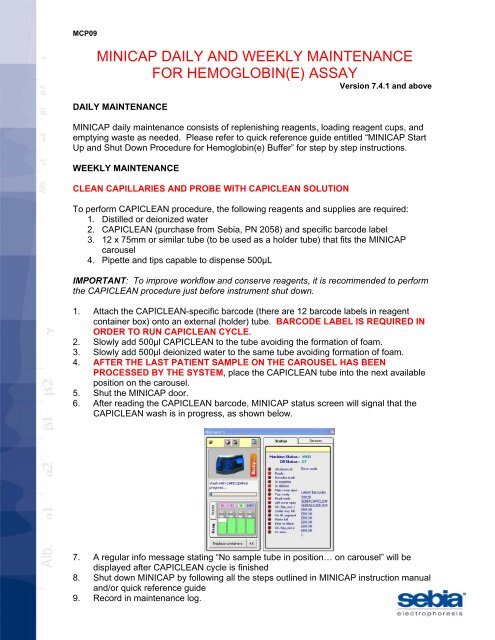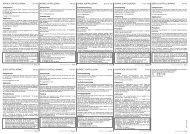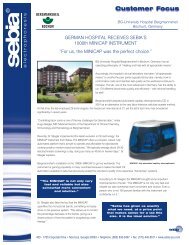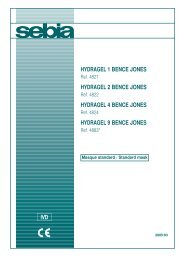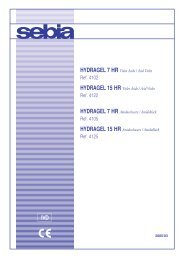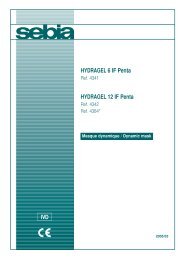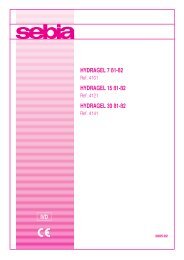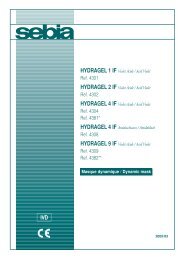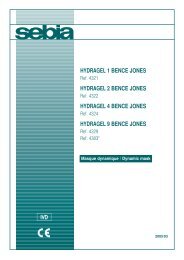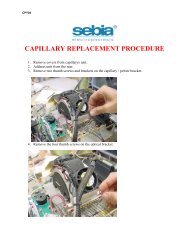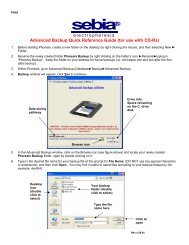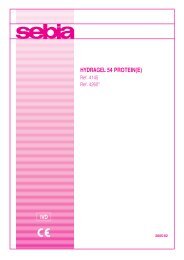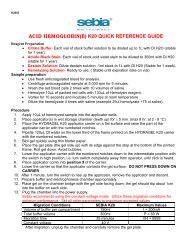MINICAP DAILY AND WEEKLY MAINTENANCE FOR HEMOGLOBIN(E) ASSAY
minicap daily and weekly maintenance for hemoglobin(e) assay
minicap daily and weekly maintenance for hemoglobin(e) assay
- No tags were found...
You also want an ePaper? Increase the reach of your titles
YUMPU automatically turns print PDFs into web optimized ePapers that Google loves.
1<br />
MCP09<br />
<strong>MINICAP</strong> <strong>DAILY</strong> <strong>AND</strong> <strong>WEEKLY</strong> <strong>MAINTENANCE</strong><br />
<strong>FOR</strong> <strong>HEMOGLOBIN</strong>(E) <strong>ASSAY</strong><br />
Version 7.4.1 and above<br />
<strong>DAILY</strong> <strong>MAINTENANCE</strong><br />
<strong>MINICAP</strong> daily maintenance consists of replenishing reagents, loading reagent cups, and<br />
emptying waste as needed. Please refer to quick reference guide entitled “<strong>MINICAP</strong> Start<br />
Up and Shut Down Procedure for Hemoglobin(e) Buffer” for step by step instructions.<br />
<strong>WEEKLY</strong> <strong>MAINTENANCE</strong><br />
CLEAN CAPILLARIES <strong>AND</strong> PROBE WITH CAPICLEAN SOLUTION<br />
To perform CAPICLEAN procedure, the following reagents and supplies are required:<br />
1. Distilled or deionized water<br />
2. CAPICLEAN (purchase from Sebia, PN 2058) and specific barcode label<br />
3. 12 x 75mm or similar tube (to be used as a holder tube) that fits the <strong>MINICAP</strong><br />
carousel<br />
4. Pipette and tips capable to dispense 500µL<br />
IMPORTANT: To improve workflow and conserve reagents, it is recommended to perform<br />
the CAPICLEAN procedure just before instrument shut down.<br />
1. Attach the CAPICLEAN-specific barcode (there are 12 barcode labels in reagent<br />
container box) onto an external (holder) tube. BARCODE LABEL IS REQUIRED IN<br />
ORDER TO RUN CAPICLEAN CYCLE.<br />
2. Slowly add 500µl CAPICLEAN to the tube avoiding the formation of foam.<br />
3. Slowly add 500µl deionized water to the same tube avoiding formation of foam.<br />
4. AFTER THE LAST PATIENT SAMPLE ON THE CAROUSEL HAS BEEN<br />
PROCESSED BY THE SYSTEM, place the CAPICLEAN tube into the next available<br />
position on the carousel.<br />
5. Shut the <strong>MINICAP</strong> door.<br />
6. After reading the CAPICLEAN barcode, <strong>MINICAP</strong> status screen will signal that the<br />
CAPICLEAN wash is in progress, as shown below.<br />
7. A regular info message stating “No sample tube in position… on carousel” will be<br />
displayed after CAPICLEAN cycle is finished<br />
8. Shut down <strong>MINICAP</strong> by following all the steps outlined in <strong>MINICAP</strong> instruction manual<br />
and/or quick reference guide<br />
9. Record in maintenance log.
2<br />
PROBE DECONTAMINATION USING BLEACH SOLUTION<br />
To perform probe decontamination, the following reagents and supplies are required:<br />
1. distilled or deionized water<br />
2. any commercially available bleach solution (purchase in any general store)<br />
3. SODIUM HYPOCHLORITE-specific barcode (included in CAPICLEAN package, PN<br />
2058)<br />
4. 12 x 75mm or similar tube that fits the <strong>MINICAP</strong> carousel<br />
5. pipette and tips capable to dispense 500µL<br />
IMPORTANT: To improve workflow and conserve reagents, it is recommended to perform<br />
the probe decontamination procedure just before instrument shut down.<br />
1. Prepare a 2% bleach solution.<br />
2. Attach the SODIUM HYPOCHLORITE SOLUTION-specific barcode from the<br />
CAPICLEAN, PN 2051, reagent box (there are 4 barcode labels per box) onto the<br />
tube with bleach solution. BARCODE LABEL IS REQUIRED IN ORDER TO RUN<br />
PROBE DECONTAMINATION.<br />
3. Pipette 500µL of bleach solution into the tube.<br />
4. WHEN THE LAST PATIENT SAMPLE ON THE CAROUSEL HAS BEEN<br />
PROCESSED BY THE SYSTEM, place the barcoded tube containing bleach into<br />
the next available position on the carousel.<br />
5. Shut <strong>MINICAP</strong> door to launch the PROBE<br />
WASH program<br />
a. In the status window, SODIUM<br />
HYPOCHLORITE barcode will be<br />
displayed as SEBIAEAUDEJAVI<br />
b. The reagent status screen will<br />
display message “Cleaning of the<br />
sample probe in progress...” during<br />
the cycle, as shown on the right.<br />
6. When cycle is finished, shut down<br />
<strong>MINICAP</strong> by following all the steps<br />
outlined in <strong>MINICAP</strong> instruction manual<br />
and/or quick reference guide<br />
7. Record in maintenance log.<br />
NOTE: If desired, probe decontamination procedure with bleach can be performed<br />
immediately after CAPICLEAN procedure.<br />
To proceed, place the SODIUM HYPOCHLORITE SOLUTION tube in the next available<br />
carousel position after the CAPICLEAN-containing tube.<br />
• Both CAPICLEAN and sodium hypochlorite tubes can be placed on the carousel at the<br />
same time, i.e., after patient sample processing is finished.<br />
• In this case, probe decontamination with bleach will start as soon as CAPICLEAN<br />
cycle is finished.
3<br />
CLEAN REAGENT BAY <strong>AND</strong> SAMPLER<br />
1. Prepare 10% bleach solution<br />
2. Wipe the reagent bay area with a 10% bleach solution<br />
a. Do not use bleach solution more than necessary (i.e., do not spray or flood<br />
the bay); bleach is corrosive!<br />
3. Wipe the rotating sampler with a 10% bleach solution<br />
4. Record the activity in the maintenance log<br />
MONTHLY <strong>MAINTENANCE</strong><br />
BACK UP THE DATABASE<br />
Please follow step by step instructions on QRG entitled Advanced Backup Quick<br />
Reference Guide for use with CDRs (request QRG number PH02 if you do not<br />
have one).<br />
Rev. 12.19.2008


